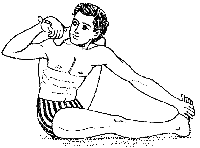This asana is easy for those who have practised Ardha Matsyendrasana for some time. Puma Matsyendrasana is a bit difficult to perform in the beginning.
some time. Puma Matsyendrasana is a bit difficult to perform in the beginning.
Technique
Sit on the floor with the legs stretched straight in front. Keep the trunk and the head in a vertically straight line. Place the right foot at the root of the left thigh. Place the right heel pressing against the navel. Keep the left foot on the floor behind the right knee. Take the right hand out from under the left knee and with the help of its thumb and first finger hold the toe of the left foot. Keep the left foot firm in this position. Take your left hand behind the back and keep the head and the body turned to the left side. Twist the waist slightly. Look at the tip of the nose. Breathe in slowly. Retain this position for twenty seconds. The position can be retained for two to three minutes after sufficient practice. This asana gives the maximum benefits when practised on the right and left sides aiternatdy.
Advantages
- This asana has all the advantages of Ardha Matsyendrasana.
- It alleviates rheumatism.
- It stimulates life energy and cures many diseases.
- It supplies fresh blood to the Prananadi. This awakens the Kundalini and the aspirant experiences mental peace and fitnness.
- This asana is very beneficial to persons suffering from 1iabet
- This asana makes the spine flexible and one experiences vigour and vitality of youth.



